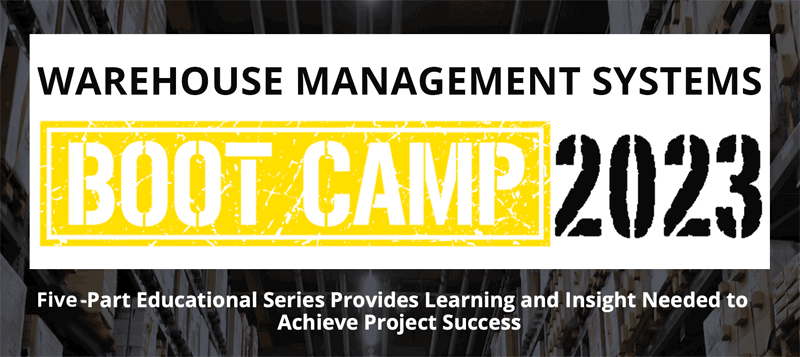eFulfillment and Bucket Brigades
I have written several times, including two weeks ago, about the apparent slowdown in ecommerce growth (See Amazon Results and the State of eCommerce.)
Of course that was inevitable, as ecommerce went from what would normally be considered as very rapid growth -13-15% year-over-year growth every quarter - then exploding even higher during the pandemic.
Eventually, you run into the "law of large numbers," and it is not surprising that consumers are reverting to pre-recession buying behaviors, notably a return to brick-and-mortar stores, and again spending money on experiences (dining out, vacations) versus exercise bikes and other home goods.
| GILMORE SAYS: |
WHAT DO YOU SAY?'
When the last/fastest worker gets done, he/she simply walks upstream until he/she encounters the picker behind them, and takes over any picks from wherever the hand-off occurred.
Send us your
Feedback here
|
In parallel to the ecommerce growth has been tremendous adoption of a wide array of hardware and software technologies to reduce the cost of the piece ("eaches") picking needed for efulfillment of individual on-line orders.
Throughput constraints are also a driver of technology adoption.
On the software side, you have traditional Warehouse Management Systems and newer Warehouse Execution Systems.
On the hardware side, my goodness, you can select from pick-to-light, Voice, goods-to-person, mobile robots, picking robots, put walls and more.
I like them all, but especially put walls, and recently came across a new variety: a "robotic out wall" solution in which robots arms select goods from a conveyor belt and placing them in the wall's "cubbie holes.
Will such investment slow down with the pause in ecommerce growth? Not much I think. Labor is still a huge issue, and piece picking remains costly. Within the past week or so, Target stores said it would add six new efulfilllment DCs, at a cost of $100 million, despite the on-line slowdown, because customers demand rapid fulfillment.
Having said that, before I invested in anything, I might try the approach to piece picking invented by the late Dr. John Bartholdi of Georgia Tech- a topic I have written about twice before.
What am I talking about? It has something to do, literally, with the birds and the bees, or I guess the bees and the ants. Somehow, Dr. Bartholdi observed that bees in the hive are able to run incredibly effective "logistics" operations, without the benefit of any technology tools. Ditto with ant colonies.
In fact, the bees don't even have a boss. The queen gets royal treatment, but she doesn't tell the drones what to do.
So how do bees do it? As best we can tell, by self-organizing, based on simple signals from surrounding bees. "Each bee or ant in a colony follows some simple rule," Bartholdi told me in 2007. "Together, they achieve tremendous organization and effectiveness on a larger scale."
Somewhere along the way, Bartholdi got to wondering just whether there were applicable self-organizing concepts for supply chain and logistics systems. Turns out there are, and that Bartholdi had been writing about them since the mid-1990s.
The most clear and proven opportunity is in order picking, or piece picking more specifically.
Provocatively, Bartholdi argued that many "work content models" (pick zones, etc.) are "almost always wrong in practice - it's just a guess." Because workers operate at different speeds, both naturally, and at any given point, they become bottlenecks, and slow down the effectiveness of the whole.
The answer: self-organization. Forget pick zones, whether static or dynamically assigned. Each worker just does the next thing they are supposed to do (more in a moment), and adjacent workers respond. Voila - the line balances itself, and productivity and throughput are substantially increased.
"The concept is too darn simple - I can't make any money on it!" Bartholdi joked when talking to me a long time ago.
 It works like this: each worker starts down a pick line, at the speed they can accomplish given their skill and the difficulty of the next pick. When the last worker finishes his/her pick at the end of the pick line, he or she walks back upstream to take over the work of their predecessor, who walks back and takes over the work of his or her predecessor and so on. It works like this: each worker starts down a pick line, at the speed they can accomplish given their skill and the difficulty of the next pick. When the last worker finishes his/her pick at the end of the pick line, he or she walks back upstream to take over the work of their predecessor, who walks back and takes over the work of his or her predecessor and so on.
This continues until, after relinquishing his/her picks, the first worker walks back to the start to begin a new set of orders/picks.
If you also then sequence the workers from slowest to fastest, Bartholidi called the system a "Bucket Brigade," and the workers will spontaneously gravitate to the optimal division of work so that throughput is maximized.
Let me try to paint the picture another way. When the last/fastest worker gets done, he/she simply walks upstream until he/she encounters the picker behind them, and takes over any picks from wherever the hand-off occurred. That worker does the same, etc., until the first picker returns to the beginning of the line.
OK, like me you are probably saying "Has it been tried? Does it work?" Apparently Yes to both questions. But I find only dated examples, and it's not clear if it's still in practice anywhere.
So I have no idea if the technique has simply faded away.
Drug store chain CVS at some point achieved a 34% productivity increase from the Bucket Brigade approach. "Most companies see a 25-50% gain," Bartholdi told me.
The concept is especially applicable for anyone using pick-to-light, as the hand-off between workers would be totally seamless. There would be a bit more overhead in that hand-off with other picking technologies, but Bartholdi said the benefits apply there as well. There are some limitations - you need fairly dense picks/higher volumes to really see the benefits. But then again, that's where costs are high.
So if it were me, I might start by implementing Bucket Brigades in piece picking, see what I get, and make choices about technology from there.
Alternatively, I would make sure if applicable that new automation supports this practice.
I conclude by saying "long live Bucket Brigades."
While I am able, I am going to keep writing about it to keep the flame alive.
What is your reaction to the Bucket Brigade approach? Let us know your thought at the Feedback section below.
|






 It works like this: each worker starts down a pick line, at the speed they can accomplish given their skill and the difficulty of the next pick. When the last worker finishes his/her pick at the end of the pick line, he or she walks back upstream to take over the work of their predecessor, who walks back and takes over the work of his or her predecessor and so on.
It works like this: each worker starts down a pick line, at the speed they can accomplish given their skill and the difficulty of the next pick. When the last worker finishes his/her pick at the end of the pick line, he or she walks back upstream to take over the work of their predecessor, who walks back and takes over the work of his or her predecessor and so on.


